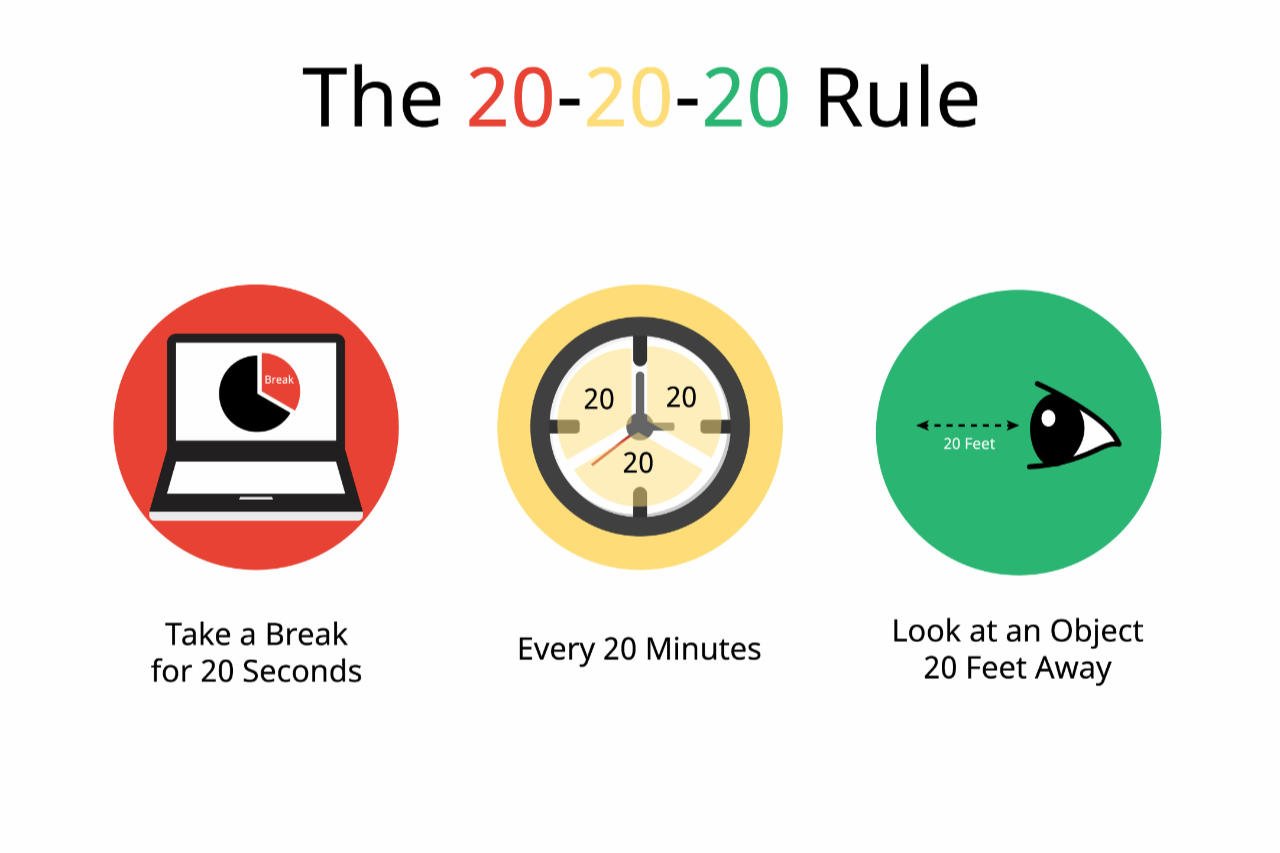Digital eye strain (DES) is caused by excessive exposure to digital devices from Display Screen Equipment (DSE), whether computer screens, laptops, smartphones or tablets.
Working on DSE for prolonged periods can leave users experiencing digital eye strain symptoms such as dry eyes, discomfort or headaches. There are, however, some healthy habits users can adopt to prevent eye strain that may be caused by Display Screen Equipment, such as the 20 20 20 rule.
Discover our Display Screen Equipment (DSE) Training to help employees adopt healthy workstation posture and how DSE can affect health.
What is digital eye strain?
Digital eye strain results from your eyes being focused on a screen activity for long periods to the point where they blink less. This results in dry eyes and eye (ocular) muscle fatigue.
According to research by the BMJ Open Ophthalmol, digital eye strain – also known as computer vision syndrome (CVS) may be prevalent in over half of all computer users.
Symptoms can include eye discomfort, such as itching and tearing, or eyes becoming very dry and red. Users with eye strain tend to experience tiredness and can struggle to concentrate. Experiencing physical discomfort at work may cause employees to feel less motivated, reducing productivity.
Read our guide on the benefits of managing employee stress and mental wellbeing.

What are the symptoms of eye strain?
Eye strain symptoms of soreness, tired, burning or itching in the eyes are the most common, but you can also experience:
- Doubled version
- Headaches
- Watery eyes
- Light sensitivity
- Sore shoulders, neck and back
- Blurred version
- Red eyes
According to scientific research by Ophthalmic and Physiological Optics, around 17% of DSE users reported blurred vision while using DSE, nearly 40% reported tired eyes, and 30% suffered from eye strain.
What are the causes of digital eye strain?
Various factors of working on DSE can cause digital eye strain.
- Screen glare – Using a screen for prolonged periods when there’s glare on the screen, which can be caused by both natural and artificial light reflecting off the screen, can contribute to digital eye strain and alter healthy postures.
- Poor environmental lighting – Working on a screen in low or high lighting levels can put extra pressure on your eyes to see the screen resulting in digital eye strain.
- Poor angle and distance to the screen – Viewing the screen from too far away or too close at an uncomfortable angle can cause digital eye strain.
- Poor posture – Incorrectly set up workstations and poor posture while using DSE can also strain your eyes if you are not looking at the screen straight on, with the risk of strain on eye muscles if you are looking at the screen from an angle.
- Undiagnosed vision problems – Working for prolonged periods on DSE if you have vision problems that are yet to be diagnosed may also result in eye discomfort.
Employers are required to provide DSE assessments for employees and provide eye tests and spectacles if the tests show that they are required. Find out now why DSE assessments are essential.
How long does digital eye strain last?
Digital eye strain symptoms are subject to various factors, such as how much time is spent looking at a screen and whether a pre-existing sight problem could intensify the symptoms.
Research found that eye strain typically eases within an hour of your last interaction with a screen. If users experience persistent eye discomfort, this could be due to an underlying eye condition that has not been diagnosed, so it would be advisable to discuss with your manager the organisation’s policy and procedures for DSE eye tests.

What is the 20 20 20 rule?
As continued focus on a screen can cause digital eye strain, employees working with DSE are encouraged to follow the 20-20-20 rule.
This exercise requires users to look away from their screen and focus their eyes on something 20 feet away for 20 seconds, as often as every 20 minutes you are working on a screen.
How can you tell something is 20 feet away?
Visualising 20 feet can be more accessible if there is a reference point. Think of objects that are roughly around 20 feet long such as the length of four park benches. Try looking out the window and looking for an object in the distance, such as a building across the road or the furthest tree you can see. You can also look across the room to the most distant object you can see and focus on that.
How to remind yourself of the 20 20 20 rule?
It’s easy to get engrossed in your work and forget to take breaks, so finding a way to remind yourself to follow the 20 20 20 rule is a good idea. Employees can set an alarm on their watch, phone, or computer to prompt them to look away from the screen. Alternatively, managers can create alerts on their computers to remind employees to take a break and look away from their screens.

Other ways to prevent digital eye strain
Aside from the 20 20 20 rule, there are other factors to help prevent digital eye strain.
- Have an eye test – The most critical factor in maintaining eye health is to ensure that employees using DSE have an eye test. Eye test costs from an optician can be claimed from an employer if the employee is a DSE user. The cost of glasses can also be claimed if they are exclusively used for DSE work. Read our guide to determine if your employer needs to pay for your eye test.
- Minimise glare – Consider undertaking a lighting survey which might find there are light sources that cause glare or that installing anti-glare screens on workplace monitors and screens might help.
- Text size – Consider adjusting text size on screen. Computer operating systems and applications often have accessibility settings that can increase text size in menus, for example, helping reduce eye strain.
- Lighting – Be aware of lighting around your workstation. If there is too much artificial light, this can cause headaches due to tension in the eye and forehead mucles. Natural light from windows is the most effective light. If this isn’t available, keep the lights at a safe level following published guidance.
- Sit back – Moving away from your screen can help ease digital eye strain. The optimum distance from the screen is about 25 inches (around 65cm), with your eye line just above the screen, so you look down slightly at it.
- Keep blinking – Eye strain can result from dry eyes caused by insufficient blinking when looking at a screen for long periods. Remembering to keep blinking while at your screen can help replenish your tears and avoid your eyes getting dry naturally.
- Dim the screen – If your screen is much brighter than the surrounding light in the room, it can strain your eyes to focus on it. Try dimming your screen to blend in with the light around you.
- Try eye drops – Using artificial tear eye drops can help replenish your eye’s natural tears and avoid drying out.
The importance of DSE training
The Display Screen Equipment (DSE) regulations (1992) are in place to help employers maintain a safe environment for employees to work on DSE and support their health. Employers’ responsibilities include ensuring employees are trained in the safest way to use DSE and that all DSE workstations are set up correctly for all employees, as well as encouraging users to take regular breaks from using DSE.
Developed by ergonomic specialists and health and safety consultants, Praxis42 DSE training for Display Screen Equipment (DSE) complies with the Health and Safety DSE Regulations for all organisations with employees who regularly use DSE.
Our in-depth IOSH Approved DSE training is designed to help employees understand how DSE can affect physical health and well-being. It offers practical guides on achieving and adopting good workstation posture and correctly establishing ergonomic working conditions.
The course covers common health issues such as eye strain alongside numerous order conditions like musculoskeletal disorders (MSDs) and fatigue. It helps workers understand the effects of poor posture on health with step-by-step teachings on adjusting chairs and screens alongside guides to create safe and practical working environments.
Find out more about DSE training from Praxis42. We also offer an online DSE self-assessment tool so employees can assess their own workstations. And for those who would benefit from tailored advice from our ergonomic specialists, we provide a Virtual Ergonomic Assessment service.

Adam Clarke
Managing Director (Consulting)
